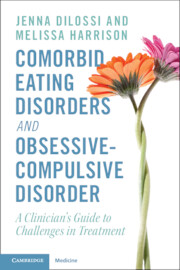 Comorbid Eating Disorders and Obsessive-Compulsive Disorder
Comorbid Eating Disorders and Obsessive-Compulsive Disorder Book contents
- Comorbid Eating Disorders and Obsessive-Compulsive Disorder
- Comorbid Eating Disorders and Obsessive-Compulsive Disorder
- Copyright page
- Contents
- Foreword
- Preface
- Acknowledgments
- Abbreviations
- Part I Overview of the Existing Literature
- Chapter 1 Understanding Eating Disorders
- Chapter 2 Review of Eating Disorder Treatment
- Chapter 3 Understanding Obsessive-Compulsive Disorder
- Chapter 4 Diagnostic Comorbidity and Phenomenological Overlap of Eating Disorders and Obsessive-Compulsive Disorder
- Chapter 5 Identifying Common Themes across Treatments for Eating Disorders and Obsessive-Compulsive Disorder
- Chapter 6 Identifying Mechanisms of Action across Treatments for Eating Disorders and Obsessive-Compulsive Disorder
- Part II Clinical Pitfalls and Treatment Failures
- Part III Evidence-Informed Considerations for Assessment and Treatment
- Part IV Special Topics and Future Considerations
- References
- Index
Chapter 3 - Understanding Obsessive-Compulsive Disorder
from Part I - Overview of the Existing Literature
Published online by Cambridge University Press: 14 December 2023
- Comorbid Eating Disorders and Obsessive-Compulsive Disorder
- Comorbid Eating Disorders and Obsessive-Compulsive Disorder
- Copyright page
- Contents
- Foreword
- Preface
- Acknowledgments
- Abbreviations
- Part I Overview of the Existing Literature
- Chapter 1 Understanding Eating Disorders
- Chapter 2 Review of Eating Disorder Treatment
- Chapter 3 Understanding Obsessive-Compulsive Disorder
- Chapter 4 Diagnostic Comorbidity and Phenomenological Overlap of Eating Disorders and Obsessive-Compulsive Disorder
- Chapter 5 Identifying Common Themes across Treatments for Eating Disorders and Obsessive-Compulsive Disorder
- Chapter 6 Identifying Mechanisms of Action across Treatments for Eating Disorders and Obsessive-Compulsive Disorder
- Part II Clinical Pitfalls and Treatment Failures
- Part III Evidence-Informed Considerations for Assessment and Treatment
- Part IV Special Topics and Future Considerations
- References
- Index
Summary
Obsessive-compulsive disorder (OCD) is characterized by persistent, recurring thoughts, images, or impulses and repetitive behaviors or mental acts that individuals are compelled to perform in order to reduce anxiety caused by obsessions. Obsessions and compulsions can be time consuming and intrusive, affecting functioning and causing distress. Symptoms of OCD can present in various domains, such as harm, contamination/cleaning, sexual behavior, symmetry/exactness, religiosity, hoarding, somatic, checking, repeating, counting, and miscellaneous. Individuals can experience distress related to multiple domains simultaneously. OCD can worsen over time as avoidance of feared stimuli can lead to increased anxiety, impaired functioning, and social isolation. Researchers have identified factors thought to maintain OCD symptoms, such as need for certainty, difficulty with change, and distress tolerance issues. Effective treatments for OCD include selective serotonin reuptake inhibitors and exposure and response prevention, which involves exposing individuals to feared objects, thoughts, or situations while preventing compulsive behaviors and is considered the gold standard OCD treatment.
Keywords
- Type
- Chapter
- Information
- Comorbid Eating Disorders and Obsessive-Compulsive DisorderA Clinician's Guide to Challenges in Treatment, pp. 16 - 27Publisher: Cambridge University PressPrint publication year: 2023
- 1
- Cited by
